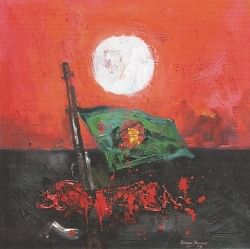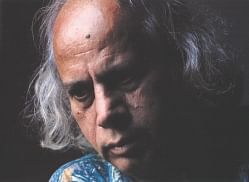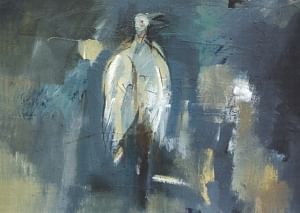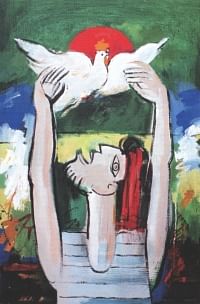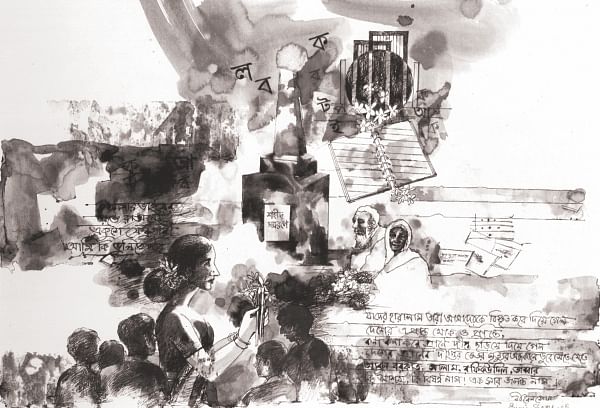| Home - Back Issues - The Team - Contact Us |
 |
| Volume 10 |Issue 28 | July 22, 2011 | |
|
|
Profile Mingling Nostalgia with Dreams Fayza Haq
Biren Shome, with his egret-white, flowing hair, tall, stately figure and dignified deportment, is a well- known figure in the Dhaka art scene. Like most local artists, he is soft-spoken, self-effacing and an enormous pleasure to be with. He has done it all and seen it all, as far as a Bangladeshi painter can go. He has followed the birth of the nation and today faces the topsy-turvy world of ours, with its global warming and endless strikes with endless cheer and bonhomie. Talking about his work over coffee in his Dhanmandi residence, Shome discusses his book illustrations, the painting he does for the galleries and his life in general. One gathers that he treated each canvas separately, after his work, and even at his office after working hours. Shome says that he joined the Herbarium in 1790. He explains that illustration work did not take him away from his more creative attempts. He says that for him his illustration work was not vital. He just took that in his stride. His paintings were done mostly at night and on holidays. His work at that time was in pen-and-ink, water colour and in oil.
At the outset Shome, painted nature – birds, flowers; social life; romantic images. He loved doing river scapes and landscapes in water-colour – in particular. His Herbarium work was detailed – microscopic, in fact. The details of flowers, which he studied as an illustrator, were enlarged and used in his paintings. And this lent depth to his more creative work on canvas. Shome says that painting is matter of the artist's mind. What the artists feels, sees is what goes into his work. If one just copies nature, he says, that is like a photographic copy of what sees. The feelings and imagination should come into the work too, he says. An artist should try to establish a style of his own, he adds. The painting should carry an individual mark–that which is different from others. One should please oneself at first. Whether it pleases the buyer or not is a secondary matter–and certainly not of primary consequence. The picture, however, at a glance, should please the viewer. The buyer should feel that it will go with his furniture and fixture, in the office or living room or which ever place he has in his mind, says Shome. After the hard days work, the picture should make feel relaxed and better. The colour and lines has to please the buyer. Here blue appears soothing, while oranges and vermilions are passionate. Warm colours tend to stand for violence, and protest– in general, he says. “Colours have to be minimised in various ways, and the composition should have a meaning, and should stir up the imagination or memories,” says the veteran artist. Sale in the art market, he stresses repeatedly, is of secondary consequence, and surely not a major factor to keep in mind. In his early days, he went in for Impressionism – which could win any viewer's heart. He naturally worked on those subjects, which moved him more than others. The Liberation Movement has been one of his favourite themes, gathering from his solo last winter at “Shilpangan”, Dhanmandi. Shome says”, Socio –economics and political factors around an artist influences his/ her work to a great extent. They work on the mind and influences the artist's work.” During the Liberation War, Shome was in Kolkata working for the Mujib Nagar Government.
He made posters, leaflets and logos in the Information Ministry. Qamrul Hasan was the Director. With Shome were Devdas Chakraborty, and his son Gautam Chakraborty, Nitun Kaundu in the Design Section. Shome also made portraits of Bangabandhu. After the March crackdown, he had fled to Jamalpur, Sherpur and then on across the Turag River on the Tripura border. Meanwhile his mother, wife and brother had escaped to Assam. Zahir Raihan, at that time, came to the office of the Design Section where Shome worked. There was work to be done by artists in the documentary film, “Stop Genocide” that the maestro was making. Here illustrations and images were necessary for the backdrop and the artists did them with great enthusiasm. What does he like most, the fine drawings or passionate brushwork? To this the prince of painting says that after the Liberation, he returned to Dhaka, his original base and began work seriously. Shome held seven solo exhibitions since then. This included ones at “Shilpangan”, Chitrak” the Art College ( Department of Fine Arts, D.U). His latest venture was “Bhasha Andalan Thikey Mukti Juddho” at Shilpangan last winter. This included innumerable drawings and paintings. This portrayed women protesting, soldiers brandishing rifles– with the “badge of courage” on their forehead, bleeding human figures, human limbs askew on the battle field– awash with blood etc. In the protest marches, the savage police action was portrayed with emotion. What the master painter wanted to portray was attack and counter attack on the battlefield, at that time. The first monument dedicated to the martyrs to Matiur, Salam and Barkat – destroyed by the then Pakistan government – and made by students at that time featured in one of his paintings.
Was it easy for Shome to reach the heights that he has reached at present? To this the illustrator cum artist says,” I took both illustrating and professional painting seriously. I did illustration in order to survive. At the same time I continued with my passion for painting, whether it brought good financial rumination or not. I had the energy to continue with my painting from time to time. To get my necessary equipment for painting, I required canvas, brushes etc. So I just had to go in for illustration, at the same time. I illustrated the Culture Page of” Sangbad”. Gradually, with time, I was employed for illustrating books, aimed at schoolchildren from the kindergarten to class V. I became well-known for drawing for the National Textbook Board. Also I managed forty group shows along with my successful eight solos. These were held at Mumbai, Delhi, Europe ( Bonn and London). These ventures were physically strenuous. The yet worth the time and sweat. I'm a full time painter now, and do illustrations only selectively–as the mood takes me. I have a shed in my Lalmatia house”. “At present, he works mainly during the daytime, to get the daylight effect. Talking about inspiration and guide in his art work Shome says that his sale of paintings began during his student days. Since the third year at the Art School in Dhaka, he has persevered wit images and hues in water-colour–which were quickly lapped up. “A lady from the Norwegian Embassy, would act as my patron,” he recounts.” She would come to the Elephant Road, Kampala Digs, where he stayed with Abul Barq Alvi and the late Mahbubul Amin. “We were third and fourth year students. They took our work home and this gave fillip to our work,” says Shome. Touching on the senior painters who influenced him as a student, Shome says that they include Aminul Islam, Mohammed Kibria, Shafiuddin Ahmed and Zainul Abedin. At that time Zainul Abedin was the adviser to the Information Ministry of Pakistan, two years before he retired from the Art College,to be based at Karachi. He was our acting Principal, coming to Dhaka from time to time. Our friendship and rapport with Zainul Abedin– and we, as students, visited his house quite often. With Qamrul Hasan, the link was strong. SM Sultan – we students met him from time to time. I believe that Kibria had the most influence on my work. The senior artists always helped with the sale of our work. Their guidance and help were vital in our existence.
When illustrating the text books for the Text Book Board what did he focus on? The work was aimed at students, says Shome, from class 1 to class X. The purpose of the illustration was to help focus on the subjects. It was a must to read the story, poem, or text, before, understand what the writer meant, and then go on to illustrating, after he had absorbed the matter before him. Here the artists did not have much freedom. “One could not impose one's ideas there. My work was to make the drawing appealing to the students. The illustrations only helped absorb the text,” says Shome. When Qayyum Chowdhury and Hashem Khan have illustrated in a very big way – who were Shome's peers? He obviously had to please his patron, “The Text Book Board”, and his peers include Naima Haque, who even composes the matters in the story books for children.
Copyright
(R) thedailystar.net 2011 |
